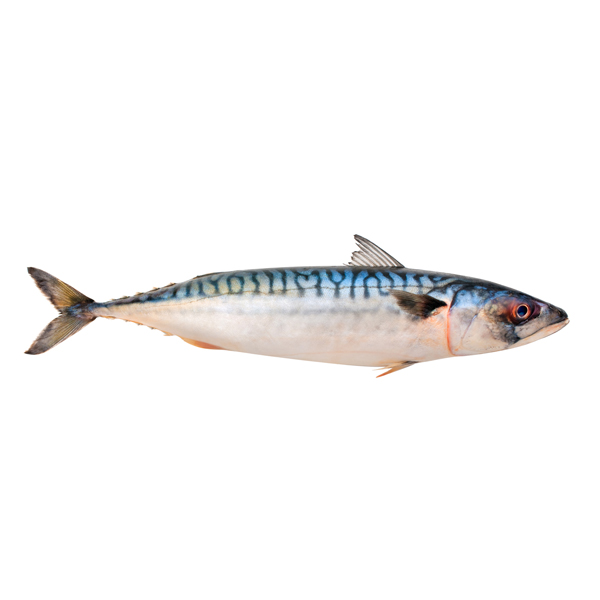
Scomber scombrus
FAMILY
Scombridae
TAXONOMY
Scomber scombrus Linnaeus, 1758, Atlantic Ocean.
OTHER COMMON NAMES
French: Maquereau commun; Spanish: Caballa del Atlantico.
PHYSICAL CHARACTERISTICS
Maximum fork length is 22 in (56 cm), commonly to 19 in (30
cm). Body fusiform, tapering rearward to a very slim caudal
peduncle and anteriorly to a pointed snout. Eyes large with socalled
adipose eyelids covering front and hind margins of the
eye except for a slit over the pupil. Mouth large, filled with
small, sharp, conical teeth in upper and lower jaws. Gill rakers,
30–36 on lower limb of first gill arch. Two widely separated
dorsal fins, the first with 11–13 spines, the second with 11 or
12 rays. Both second dorsal and anal fins followed by five finlets.
Entire body covered with small scales. Swim bladder usually
absent. Vertebrae, 31. Upper surface dark steely to
greenish blue. Body barred with 23–33 dark transverse bands;
belly unmarked.
DISTRIBUTION
North Atlantic Ocean, including the Baltic, Mediterranean,
and Black seas. Replaced by other species of Scomber in other
oceans.
HABITAT
An epipelagic and mesodemersal species, most abundant in
cold and temperate shelf areas.
BEHAVIOR
Mackerel are swift-moving, swimming with very short sidewise
movements of the rear part of the body and the powerful caudal
fin. They need so much oxygen that they must swim constantly
to bring sufficient water across their gill filaments.
Mackerel gather in dense schools of fish that are approximately
the same size and age. They overwinter in moderately deep
water along the continental shelf and move inshore and northward
in the spring.
FEEDING ECOLOGY AND DIET
Atlantic mackerel are opportunistic carnivores that swallow
their food whole. Food is captured by active pursuit or by passive
filtration with the gill rakers. Juveniles feed on zooplankton.
Adults also eat crustaceans but add squids and small fishes
to their diet.
REPRODUCTIVE BIOLOGY
In the western North Atlantic, spawning takes place from
Chesapeake Bay to Newfoundland, beginning in the south
in spring and progressively extending northward into the
summer. Most spawning occurs within 10–30 mi (16–48 km)
of shore. Mackerel do not begin spawning until the water
has warmed to approximately 46.4°F (8°C). The chief production
of eggs takes place at temperatures of 48.2–57.2°F
(9–14°C). Maturity is attained at 2–3 years of age. Estimates
of fecundity range from 285,000 to 1.98 million eggs for
females 12–17 in (307–438 mm) fork length. The eggs are
0.04–0.05 in (1.09–1.39 mm) in diameter, have one oil globule,
and generally float in the surface water layer above the
thermocline.
CONSERVATION STATUS
Not threatened.
SIGNIFICANCE TO HUMANS
Mackerel are delicious fish but do not keep as well as fishes
that have less oil in their tissues. There are important fisheries
in the northwest Atlantic, northeast Atlantic, and Mediterranean
and Black seas. FAO catch statistics for 1991–2000
show catches of 6.16–9.42 thousand tons (5.59–8.55 thousand
metric tons) per year by 36 countries. Atlantic mackerel are
caught mainly with purse seines. Mackerel also are taken by
anglers; the all-tackle world record is a 3-lb (1.2-kg) fish taken
off Norway.
Photo Gallery of - Atlantic mackerel





 Animalia Life
Animalia Life